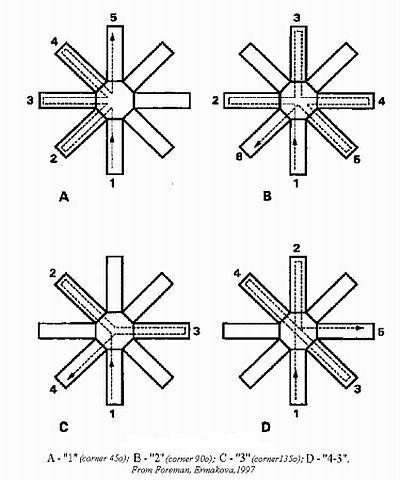
Algorithmic analysis of rat behavior in a radial water maze
I.V. Ermakova
Laboratory of Pathology & Therapy of Neuroscience, Institute for Higher Nervous Activity & Neurophysiology, Moscow, Russian Federation
A number of authors have shown that the direction taken by rats searching lateral platforms in radial mazes is not always random [1]. In some cases, a clear preference is observed for a platform in a certain corner (e.g. one at 45º, 90º or 135º). The consecutive passage of channels (corner 45º) is designated as '1', passage through one channel (90º) corner as '2', and so on (see Figure 1).

Figure 1. Algorithms in 8-arm radial maze.
In the present work, we analysed the search algorithms of lateral platforms made by two groups of rats in an 8-arm radial water maze (RWM). One group of rats contained intact controls, but the other comprised those with disturbed spatial memory, following unilateral and bilateral lesion of their amygdala by kainic acid.
Most intact animals preferred algorithms '1' and '2', though pairs of algorithms (e.g. '4,3') and complex combinations (e.g. '3,2,1') were also found. In contrast, rats with unilateral amygdala lesions preferred algorithm '2', while those with bilateral lesions preferred algorithm '3' (corner 135º). No complex algorithms were recorded in these experimental rats.
Thus, rats with amygdalal lesions made fewer consecutive passes through channels, and were not observed to construct any complex algorithms.
References
Paper presented at Measuring Behavior 2002 , 4th International Conference on Methods and Techniques in Behavioral Research, 27-30 August 2002, Amsterdam, The Netherlands